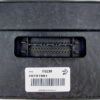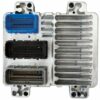Restore Your Vehicle’s Fuel System with a VIN-Programmed FPCM
Is your 2009 Chevrolet Traverse, or another compatible GM vehicle, suffering from perplexing fuel-related issues? Symptoms like engine stalling, hesitation during acceleration, a check engine light, or a complete no-start condition can often point to a failing Fuel Pump Control Module (FPCM), also known as a Fuel System Control Module (FSCM). This critical component is responsible for precisely managing the voltage supplied to your vehicle’s fuel pump, ensuring optimal fuel pressure and engine performance. When it fails, it can leave you stranded and facing a complicated repair. We offer a direct, reliable solution: a replacement FPCM, part number 25854536, that comes fully programmed to your vehicle’s specific Vehicle Identification Number (VIN).
The Modern Fuel System’s Brain
Unlike older, return-style fuel systems that ran the fuel pump at full speed constantly, modern vehicles utilize a more sophisticated approach. The FPCM acts as a dedicated computer for the fuel pump. It receives commands from the main Engine Control Module (ECM) and modulates the pump’s speed based on real-time engine demand. This demand-based system reduces wear and tear on the fuel pump, improves fuel efficiency, and lowers evaporative emissions. However, due to its location (often on the frame rail or crossmember), the FPCM is exposed to harsh conditions—road salt, water, vibration, and heat—which can lead to internal corrosion and electronic failure over time.
From the Diagnostic Bay
We had a 2009 GMC Acadia (which shares the same platform as the Traverse) towed in with a classic intermittent stall. The owner had already replaced the fuel pump himself, but the problem persisted. The vehicle would run fine for days, then suddenly die at a stoplight and refuse to restart for an hour. When we scanned it, we found a P069E code stored in the ECM, pointing to an issue with the FPCM. A visual inspection of the original module revealed a corroded connector and a swollen case. We installed one of our VIN-programmed modules, and the vehicle ran perfectly. It’s a textbook example of how a faulty FPCM can mimic a bad fuel pump, making proper diagnosis essential.
Common Symptoms of a Failing 2009 Traverse Fuel Pump Module
- ✔ Engine Stalling: The engine may stall unexpectedly while driving or idling, often without warning.
- ✔ No-Start Condition: The engine cranks but will not start due to a lack of fuel pressure.
- ✔ Hesitation or Stumbling: The vehicle may hesitate or stumble during acceleration as the module fails to command the correct fuel pressure.
- ✔ Reduced Engine Power: The vehicle may enter a ‘limp mode’ with significantly reduced power.
- ✔ Check Engine Light: Diagnostic Trouble Codes (DTCs) such as P069E, P0230, P025A, or U0109 are commonly associated with FPCM failure.
- ✔ Loud Fuel Pump: In some cases, a failing module may cause the fuel pump to run at full speed continuously, creating a loud humming or whining noise from the fuel tank area.
The Plug-and-Play Advantage: No Dealer Required
One of the biggest hurdles in replacing a modern electronic module is the need for vehicle-specific programming. Traditionally, this meant having your vehicle towed to a dealership for an expensive programming session with their proprietary tools. Our process eliminates that step entirely. When you purchase this module, you provide us with your vehicle’s VIN. Our technicians then use certified equipment to load the latest GM-approved software and calibration files directly onto the module. The part you receive is a true plug-and-play component, ready for immediate installation. This saves you hundreds of dollars in programming fees and towing charges, and significantly reduces your vehicle’s downtime.
Installation and Location
On the 2009 Chevrolet Traverse, the FPCM is typically located on the rear crossmember. For many of the compatible trucks and SUVs like the Silverado, Sierra, and Tahoe, it is found mounted to the driver’s side (LH) frame rail, usually above the spare tire. Installation is straightforward for a moderately skilled DIYer or any professional mechanic. Always disconnect the negative battery terminal before beginning work. Simply locate the old module, disconnect the electrical connector, unbolt it from the frame, and install the new one in its place. Reconnect the connector and battery, and you’re ready to go.
This Module is a Direct Replacement for the Following Part Numbers:
13501024, 15213110, 20759945, 20850907, 25785013, 25854536, 25866052, 25967325
Extensive GM Vehicle Compatibility:
This FPCM fits a wide range of GM trucks and SUVs. Please verify your vehicle’s fitment using the list below or by matching your original part number. This module is compatible with:
- Acadia (2009)
- Avalanche 1500 (2008-2009)
- Canyon / Colorado (2009)
- Enclave (2009)
- Escalade, ESV, EXT (2008-2009)
- Express / Savana 1500 Van (2008-2009)
- Hummer H2 (2008-2009)
- Hummer H3 (2009)
- Outlook (2009)
- Sierra / Silverado 1500 (2007 New Body Style, 2008-2009)
- Suburban 1500 (2008-2009)
- Tahoe (2008-2009)
- Traverse (2009)
- Vue (2008-2009)
- Yukon / Yukon XL 1500 (2008-2009)
Frequently Asked Questions
Do I need to get this module programmed by a dealer?
No. The main benefit of our service is that we program the module for you before it ships. Simply provide your VIN during checkout, and the module will arrive ready for a plug-and-play installation, with no further programming required.
What happens if I install it without programming?
An unprogrammed Fuel Pump Control Module will not work correctly. It lacks the specific software and calibration data for your vehicle’s engine, transmission, and fuel system. This will result in a no-start condition and will likely set communication-related trouble codes.
Where is the FPCM located on my 2009 Traverse?
For the 2009 Chevrolet Traverse, the FPCM is mounted on the rear crossmember. For most compatible trucks and large SUVs like the Tahoe or Sierra, it is located on the inside of the driver-side frame rail, often near or above the spare tire.
How do I provide my VIN for programming?
After you complete your purchase, you will need to send us a message with your 17-digit Vehicle Identification Number (VIN). We cannot ship the module until we receive this information, as it is essential for the programming process.
Is this a new part?
This is a high-quality, tested replacement part that is guaranteed to perform to OEM specifications. We load it with the newest software updates from GM to ensure optimal performance and longevity.



